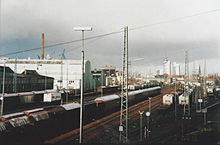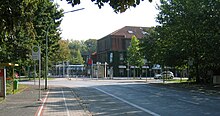Rail traffic in Bremerhaven
The rail traffic in Bremerhaven subject to constant change. Freight traffic depends largely on the operation of the ports in what is now Bremerhaven - the three then independent Lower Weser towns of Bremerhaven , Geestemünde and Lehe . The city of Bremerhaven lies at the end of a main railway line that for a long time - even in the first years of the IC network from 1971 - was served by national long -distance passenger transport. The current use is mainly related to the expansion of the container terminal .
The Bremerhaven tram belonged to the rail traffic in Bremerhaven from 1881 until it was closed in 1982 .
history
The end point of the Bremen – Bremerhaven railway line opened in 1862 was initially in Geestemünde, which at that time still belonged to the Kingdom of Hanover and from 1866 to the Province of Hanover . In 1896 and 1899 further routes were added to the surrounding area.
The port of Bremerhaven (and in 1896 also the Bremerhaven – Cuxhaven railway ) was initially connected via a branch line branching off just before the first Geestemünder station. Only goods traffic and special emigrant trains to the Lloydhalle were allowed on this route, normal passenger traffic was not. The (then smaller, but much more important) city of Bremerhaven did not have its own train station with passenger services.
By 1914, today's more efficient route for passenger traffic and port connections was created via today's main station in Geestemünde (1947 main station Bremerhaven) and the Lehe station . The old station was downgraded to a freight yard. In the last few decades, changes in the operation of the port have led to the closure of many tracks in older port areas, while the railway connection is playing an increasingly important role in container and car loading . Numerous block trains with corresponding lengths are led here.
| Scope and development of the railway facilities in Bremerhaven | |||||||||||||||||||||||||||||||||||||||||||||||||||||||||||||||||||||||||||||||||||||||||||||||||||||||||||||||||||||||||||||||||||||||||||||||||||||||||||||||||||||||||||||||||||||||||||||||||||||||||||||||||||
|---|---|---|---|---|---|---|---|---|---|---|---|---|---|---|---|---|---|---|---|---|---|---|---|---|---|---|---|---|---|---|---|---|---|---|---|---|---|---|---|---|---|---|---|---|---|---|---|---|---|---|---|---|---|---|---|---|---|---|---|---|---|---|---|---|---|---|---|---|---|---|---|---|---|---|---|---|---|---|---|---|---|---|---|---|---|---|---|---|---|---|---|---|---|---|---|---|---|---|---|---|---|---|---|---|---|---|---|---|---|---|---|---|---|---|---|---|---|---|---|---|---|---|---|---|---|---|---|---|---|---|---|---|---|---|---|---|---|---|---|---|---|---|---|---|---|---|---|---|---|---|---|---|---|---|---|---|---|---|---|---|---|---|---|---|---|---|---|---|---|---|---|---|---|---|---|---|---|---|---|---|---|---|---|---|---|---|---|---|---|---|---|---|---|---|---|---|---|---|---|---|---|---|---|---|---|---|---|---|---|---|---|
|
|||||||||||||||||||||||||||||||||||||||||||||||||||||||||||||||||||||||||||||||||||||||||||||||||||||||||||||||||||||||||||||||||||||||||||||||||||||||||||||||||||||||||||||||||||||||||||||||||||||||||||||||||||
There were only a few connections along today's main route, apart from the freight yards. Most of the railway facilities are concentrated in the two port areas:
Ports south of the Geeste
The Geestebahn initially ended for passenger traffic in Geestemünder Bahnhof . A branch line connected the port of the then city of Bremerhaven exclusively for freight traffic and emigration traffic. Individual connections to the Holzhafen , the gas works and the Tecklenborg shipyard branched off from this branch line on the Geestemünder side .
The first Geestemünder passenger (until 1914) and freight station was located directly at the trading port, parallel to it on its east side. Additional port tracks were therefore largely unnecessary at first. In 1865 its west side and the petroleum shed were connected. The Seebeck shipyard was later established there.
During the construction of the fishing port (I) from 1891 to 1896, tracks to the quays and the first fish dispatch station (Geestemünde) were built. For the further expansion of the fishing port (II) 1921–1925, a new access road including a new marshalling yard, fish dispatch station and extensions at Bremerhaven-Wulsdorf station were built for train separation. The sea dike track opened up the west side of the fishing port II since the early 1930s.
With the decline of the German fishing industry, the dismantling of the railway systems in the fishing port began in 1976. The decline in general cargo transport and the shipbuilding industry also resulted in further dismantling. Only a few siding, u. a. the Labrador Harbor, which was only built and connected in the 1980s, is still there. At the beginning of the 2000s, the Bad Bederkesa Museum Railway built a platform on the unused facilities of the marshalling yard near the “Schaufenster Fischereihafen” as the end of its trains; however, the track to Wulsdorf was closed in 2017.
Ports north of the Geeste
The Geestebahn initially ended for passenger traffic in Geestemünde . A branch line connected the port of the then city of Bremerhaven exclusively for freight traffic and emigration traffic. After the Bremerhaven – Cuxhaven railway was initially connected via this branch line in 1896 , it was also given two platforms east of the old Geestemünder station building.
On the Leher and Bremerhaven side, the sidings of the Rickmers shipyard later branched off, which kept part of the branch line alive beyond 1921. The railway ran in a wide arc to the old and new ports of Bremerhaven. The course of the route can still be seen today on the course of Bogenstrasse. The Bremerhaven freight yard was built on the east side of the New Harbor. From there, tracks led to the east and west side of the Old Harbor and - backwards - to the west side of the New Harbor, where the old Lloydhalle was built in 1869, through which the emigrant traffic was handled. When the old and new ports were connected, swing bridges replaced the fixed land connection.
When the Kaiserhafen (I) was built, the existing tracks were initially extended backwards from the freight station. In 1896 the "Zollinlandbahnhof" was opened as a freight and marshalling yard. The old branch line was connected with a triangular track. In addition, the track systems of Kaiserhafen I were connected more directly by a wide arch. Two more arches connected new port facilities further north, including the new Lloydhalle, which was opened in 1897 at the outer harbor of the Great Imperial Lock.
These arches were replaced by new approaches from Bremerhaven-Speckenbüttel around 1912 when the imperial ports were further expanded. There, on the Bremerhaven – Cuxhaven railway line built in 1896 , a marshalling yard was to be built (which, however, was not properly implemented for container traffic until the 1980s). The Kaiserhafen train station was realized, which now distributed traffic to the ports. On the way to the new Lloydhalle and from 1927 to the Columbus station , the connecting port had to be crossed for further port expansion. The largest rotating railway bridge in Germany with two tracks and two vehicle lanes was built by 1930. In 1921 and 1923 the old branch line and the customs inland station were closed and dismantled.
Further expansions of the railway facilities took place in connection with the ore handling (1964-1993) and the car and container handling.
The Nordhafen station and the tracks of the container terminal were also built (1971). At the same time, many older railway systems in the southern areas of the overseas ports became superfluous and shut down.
Current expansion
In 2015, the Kaiserhafen port station was electrified and the station's tracks were extended, and the Imsumer Deich port station was expanded to 16 tracks by 2017.
Some of the railway facilities in the overseas port belong to the city of Bremen, which is managed by DB Cargo Germany .
The rail facilities in the container terminal belong to Rail Terminals Bremerhaven (RTB), a company that has existed since 2010, half of which is owned by Eurogate and the Maersk subsidiary APM Terminals . The handling volume is over 500,000 TEU, and more than 130 block trains are processed in and out each week.
The track systems of Deutsche Bahn for block trains with containers were rearranged with the Speckenbüttel station. The block trains with export vehicles are parked in the former Bremen-Gröpelingen marshalling yard before they continue to be loaded onto ships to Bremerhaven.
Railway lines
- Bremerhaven – Bederkesa railway line
- Bremerhaven – Bremen railway line
- Bremerhaven – Buxtehude railway line
- Bremerhaven – Cuxhaven railway line
- Niederweserbahn
literature
- Walter Bollen: Railway station by the sea, the railway on the Lower Weser . Hauschild Verlag 2006, ISBN 978-3-89757-343-7
- Frank Binder: The rail infrastructure will be expanded in 2015 . Daily port report of December 17, 2014, p. 4
- Rolf Geffken : In the 1950s at the Leh freight yard. Memories of a childhood between the Elbe and Weser . In: Men from Morgenstern , Heimatbund an Elbe and Weser estuary e. V. (Ed.): Niederdeutsches Heimatblatt . No. 789 . Nordsee-Zeitung GmbH, Bremerhaven September 2015, p. 3–4 ( digitized version [PDF; 377 kB ; accessed on August 3, 2020]).
Web links
- Operational management on the connecting track from the Bremerhaven train station to the inland customs station and the Kaiserhafen in Bremerhaven; also operating regulations (State Archive Bremen) in the German Digital Library
- More pictures
Individual evidence
- ↑ Eckhard-Herbert Arndt: Success with car transport by rail · In 2014, BLG subsidiary achieved transport volumes of a good 600,000 new vehicles - 1,275 wagons . In: Daily port report of December 17, 2014, p. 4
- ^ Eisenbahn-magazin, issue 2, 2016, p. 30
- ↑ Michael Müller: RTB achieves a port railway record . In: Daily port report from August 12, 2013, p. 3

